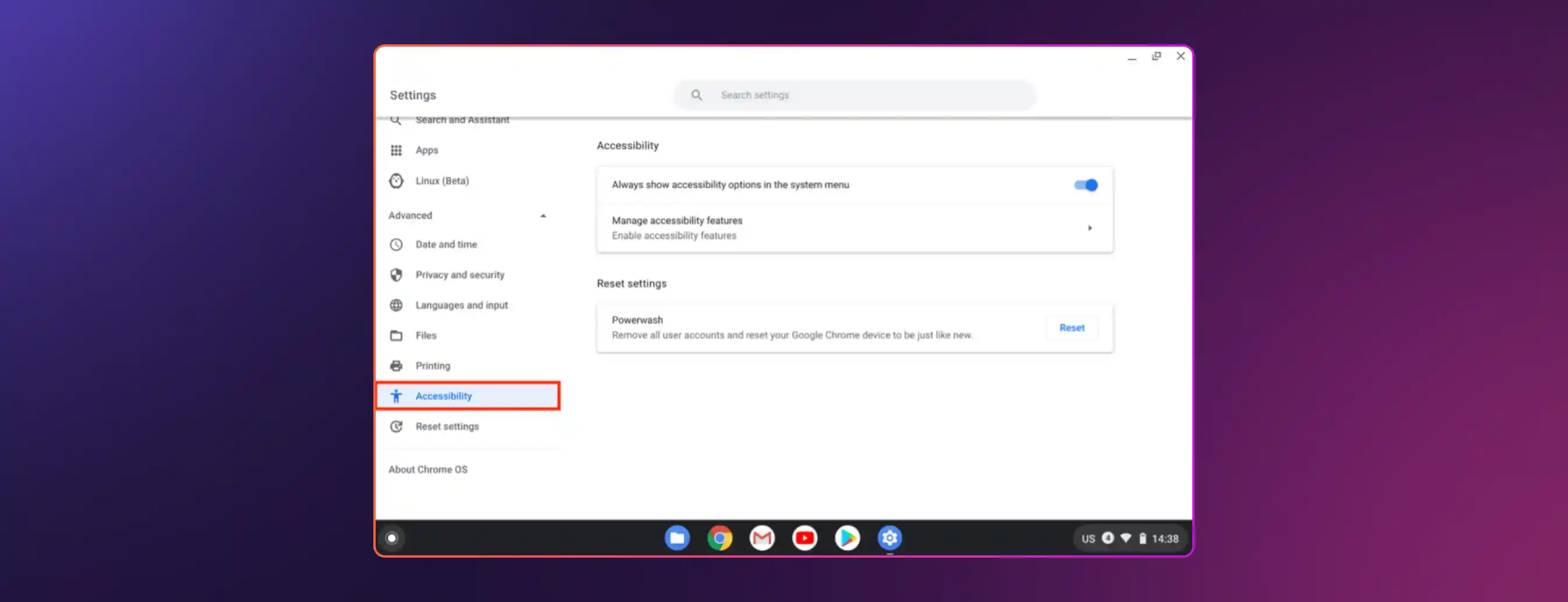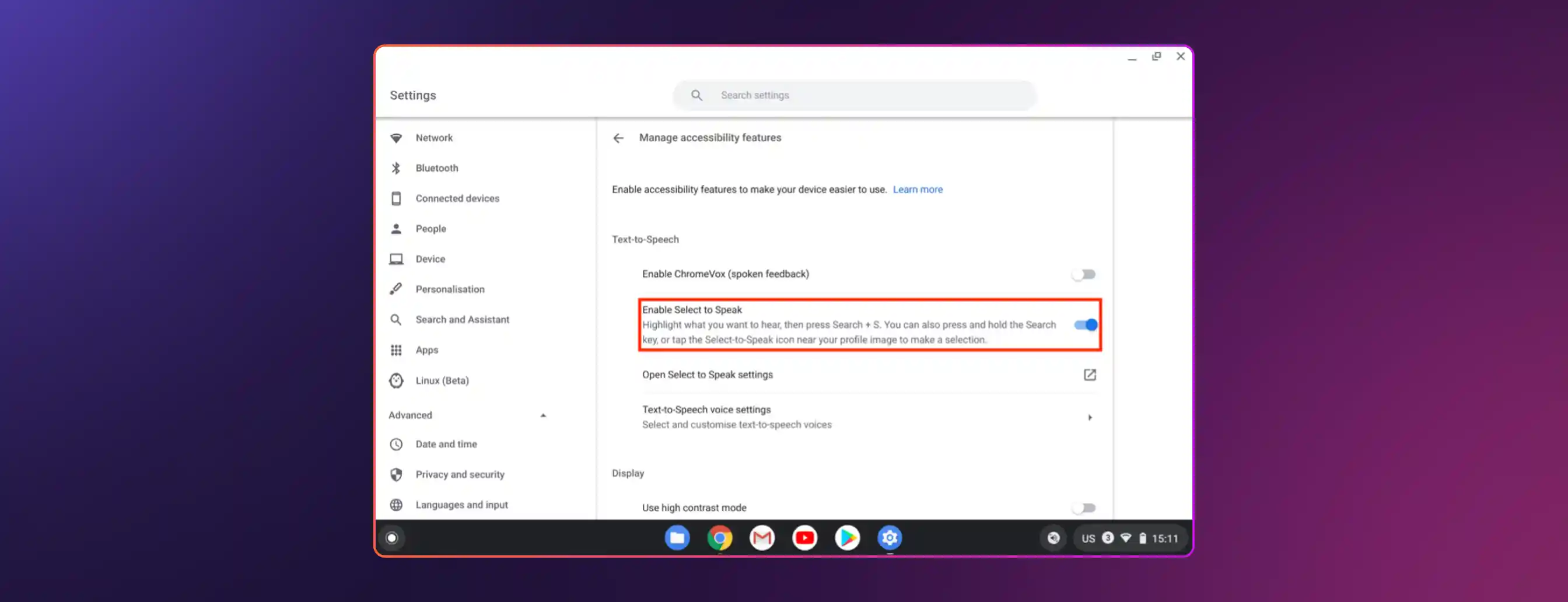How to Turn off Text to Speech on Chromebook

Text to speech (TTS) software is essential for improving digital content accessibility, especially for those with visual impairments or learning disabilities.
ChromeVox is the built-in screen reader on Chromebooks, crafted to assist those with visual impairments by vocalizing text and offering spoken feedback for information displayed on the screen. It enables users to explore webpages, documents, and apps, enhancing the accessibility of Chromebooks for a broader audience.
Alongside ChromeVox, Chromebooks provide the Select to Speak feature, enabling users to highlight particular sections of text and listen to them being read aloud. This feature is especially beneficial for users who seek spoken feedback for specific sections of a webpage or document rather than ongoing narration.
While ChromeVox and Select to Speak offer basic support on Chromebooks, they lack the flexibility and advanced features found in third-party TTS tools, such as customizable voices and enhanced speech recognition.
In this guide, we'll show you how to turn off text to speech on Chromebook, whether you accidentally activated it or no longer need it. We’ll also explore how third-party text to speech (TTS) tools can enhance your experience by offering more customization options and user-friendly features.
Turning off Text to Speech on Chromebook: A Step-by-Step Guide
To learn how to disable text to speech on Chromebook, just follow the steps given below. You can easily disable these built-in tools through the device's settings or text to speech settings
Step 1: Accessing the Chromebook Settings Menu
Open settings panel, to do that, click the clock in the lower-right corner of your screen. Next, select the gear symbol to access Settings.

Step 2: Navigating to the “Accessibility” Section
In the Settings menu, scroll down until you reach the Advanced section. Click to expand this section, then search for Accessibility. Select Accessibility to uncover additional options for accessibility tools.

Step 3: Disabling ChromeVox (Spoken Feedback)
In the Accessibility settings, find the option to Manage Accessibility Features. Locate the ChromeVox option, also known as Spoken Feedback, and set the toggle to off. This will turn off Chrome voice assistant.

Step 4: Turning Off Select-to-Speak
ChromeVox offers ongoing spoken feedback, whereas the Select-to-Speak feature reads aloud the text you select when you opt for it. To disable this feature, simply scroll down in the Accessibility menu until you find the Select-to-Speak option and toggle it off. This will completely turn off Chromebook voice assistant.

Step 5: Verify the Changes
Once you disable text to speech i.e. both ChromeVox and Select-to-Speak, return to your Chromebook's main screen and interact with it to verify the complete deactivation of the text to speech feature. It's important to observe that there is a lack of spoken feedback while navigating the interface.
To enable chromevox spoken feedback you can follow the same steps and switch on the toggle. However, if you're looking for voice functionality with added customization, look into third-party text to speech tools for a more personalized experience.
Why Opt for Third-Party TTS Tools Over Built-In Solutions?
Chromebooks offer built-in text to speech functionality, but third-party TTS tools can deliver a much better user experience with advanced features and customization options.
Here's why choosing third-party TTS solutions could be a more beneficial choice:
1. A Wide Range of Voice Options
In contrast to built-in tools such as ChromeVox, third-party text to speech software typically offers an impressive variety of voice options on the basis of age groups, gender, and even explore different tones or accents. No matter if you enjoy a warm, soothing voice for your leisure reading or a clear, authoritative tone for professional documents, third-party TTS tools provide remarkable flexibility.
2. Language Support and Accents
There are many languages available for ChromeVox, including Catalan, English (United Kingdom), Spanish, Swedish, Hebrew, Arabic, Farsi, Hindi, Simplified Chinese, and Japanese.
This selection offers a variety of languages, yet it may seem restrictive for users seeking greater flexibility in language or accent choices. Individuals seeking diverse accents or languages or those in need of assistance with less common languages may discover that ChromeVox's features fall short.
Conversely, third-party TTS tools are particularly beneficial for users who manage accessibility features speak multiple languages or are in the process of learning a new one, as it allows you to select settings for specific accents (e.g. British, American, Australian) to improve understanding.
3. Real-Time Web Article and Email Reading
Numerous third-party TTS applications provide browser extensions that can read aloud from web content and emails in real time. This is a transformative tool for anyone seeking help managing extensive amounts of online content. These tools can highlight text as it reads, enhancing accessibility and capturing user interest.
Meet Murf Text to Speech: Your Comprehensive All-in-One Solution
ChromeVox provides a handy text to speech feature on Chromebooks, but Murf AI elevates the experience with its advanced and customizable options, making it a superior choice for users with varied needs.
Here's a breakdown of its key features:
1. Natural-Sounding Voices
Murf AI stands out with its impressive selection of over 200+ realistic, studio-quality voices in more than 20 languages, unlike ChromeVox, which has a more limited range of voices and basic customization options.
Users have the opportunity to select from a diverse range of accents, tones, and genders, enabling them to customize the voice to their liking. The flexibility offered here is essential for crafting content that strikes the perfect balance between professionalism and personalization an aspect that ChromeVox falls short on.
2. Advanced Voice Customization
ChromeVox offers basic spoken feedback, whereas Murf AI enables a high level of customization for voice output. Users have the ability to adjust key elements such as pitch, speed, and emphasis to match the tone of their content.
Incorporating pauses allows speech to flow naturally, creating a more immersive experience for listeners. ChromeVox offers limited detailed controls, confining users to preset voice settings.
3. Murf Speech Gen 2 Features
Murf Speech's Gen 2 upgrade brought many advanced features that enhance the user experience even more, such as:
AI-Enhanced fidelity and Precision
Murf Speech Gen 2 brings a new level of fidelity and precision to AI-generated voices, powered by its cutting-edge generative neural architecture.
With over 70,000 hours of ethically sourced speech data, this model creates voices that sound just like human speech, embodying the complete spectrum of human emotions and nuanced inflections.
Featuring a native 44.1 kHz sampling rate, it guarantees crystal-clear sound quality, particularly for challenging combinations such as 's' and 'f' sounds. Murf's deep linguistic modeling layer boasts an impressive 98.8% word-level pronunciation accuracy, ensuring it captures accents and nuances with remarkable precision across various languages.
Word-Level Emphasis
Murf's Word-Level Emphasis feature offers precise control over voiceovers, enabling creators to accentuate or spotlight particular words for enhanced effect. This tool enables you to make precise adjustments at the word level.
Providing the option to adjust vocal elements within sentences enhances the delivery of nuanced and expressive voiceovers that connect more powerfully with your audience.
ChromeVox lacks the detailed control needed for such customizations, often resulting in less engaging audio experiences.
Murf AI provides a versatile text to speech platform, allowing users to adjust voices to match the tone and intent of their content seamlessly.
It resonates with audiences through its multilingual support, offering over 20 languages and accents to create authentic, global connections. Its customization features adjusting pitch, speed, and emphasis help tailor voiceovers to match emotional tones, making content more engaging.
Additionally, with high-quality, human-like voices and voice cloning, Murf ensures a relatable and consistent experience that enhances audience connection. Sign up below!
Meet Murf Falcon: The Fastest, Most Efficient Text to Speech API
Murf Falcon is engineered to deliver human-like speech at an industry leading model latency of 55 ms across the globe. Use Falcon to deploy AI voice agents that not only talk like regular humans, but also deliver the speech at blazing fast speed with ultra precision.
Falcon is the only TTS API that consistently maintains time-to-first-audio under 130 ms across 10+ global regions, even when processing up to 10,000 calls at the same time. Falcon delivers uninterrupted, natural speech. No lag, no clipped phrases, no robotic tone.
Engineered for Real-Time Performance
Falcon’s architecture is tuned specifically for ultra-low latency and responsiveness:
- Model latency under 55 ms
- Time-to-first-audio under 130 ms
- Edge deployment across 10+ regions for global consistency
Its lightweight, compute-efficient model outperforms larger LLM-based TTS systems on context precision and response timing delivering premium naturalness without inflated infrastructure demands.
Human-Like Speech, in Any Language
Falcon ensures voices sound fluent and expressive:
- 35+ languages, 150+ expressive voices
- Code-mixed multilingual output without accent distortion
- 99.38% pronunciation accuracy
- Conversational prosody for natural tone, rhythm, and pauses
Falcon separates how words are pronounced from the unique qualities of the speaker’s voice, preventing odd tone changes. This also enables the voice to switch languages smoothly in the middle of a sentence.Your AI voice doesn’t just speak multiple languages, it sounds native in each.
Integrates in Minutes
Falcon fits easily into modern development stacks:
- RESTful API
- Python, JavaScript, and cURL SDKs
- Works with Twilio, Anthropic Claude, Discord, and more
Go from API key to live call in minutes, no complex provisioning or specialized infrastructure needed.
Stable and Cost-Efficient at Scale
- Supports 10,000+ concurrent calls with no latency drop
- Predictable performance worldwide via edge routing
- On-prem deployment option for full internal control
- Priced at 1¢ per minute, reducing voice agent costs by up to 50%
Fast everywhere. Accurate always. Affordable at scale. Try Murf Falcon now!

Frequently Asked Questions
How do I turn off text to speech on my Chromebook?
.svg)
To turn off text to speech on your Chromebook, go to Settings > Advanced > Accessibility. Then, toggle off both ChromeVox (Spoken Feedback) and Select-to-Speak options.
Can I turn off ChromeVox without affecting other accessibility features?
.svg)
Yes, turning off ChromeVox will only disable the spoken feedback feature. To completely disable google assistant and other accessibility options like the high contrast mode or magnification you will need perform other steps.
Can I use third-party TTS tools on my Chromebook?
.svg)
Absolutely! Many third-party TTS tools, such as Murf AI, offer browser extensions that work seamlessly on Chromebooks and provide enhanced voice customization and flexibility.
Why should I choose third-party TTS tools over Chromebook’s built-in options?
.svg)
Third-party tools often offer more customization, a wider selection of voices, and better support for multiple languages and accents than built-in options like ChromeVox.















